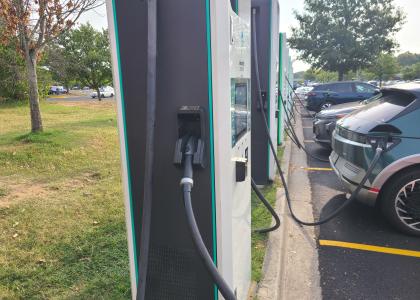Property Assessed Clean Energy (PACE) is a financing instrument for implementing energy efficiency or renewable energy projects. In its most basic form, PACE enables property owners to finance up to 100% of the upfront cost of clean energy projects, and is paid through a voluntary assessment on their property tax bill. The funds for financing PACE can come from the local government that enables the PACE program, or they can be provided by a third-party financier (the predominant approach). The financing method is typically similar to a loan with a term length and interest rate, but unlike a loan, it is tied to the property and not the individual property owner/borrower. PACE transactions can also use other forms of financing like leases and power purchase agreements (PPAs), but the loan-like structure of repayment—principal plus interest—is the most common. However it should be noted that PACE assessments and transactions are not technically loans, so the term “PACE loan” is a misnomer.
While PACE is a relatively new financing mechanism for clean energy, having first been introduced in 2007, it is based on land-secured financing districts, which have been in use by the government for more than 100 years (Zimring 2010). In a land-secured financing district, or assessment district, a local government can raise funds via bond issuance to pay for public infrastructure improvements. PACE creates assessment districts at the property level, allowing private property owners to make improvements using the same approach. Whether PACE funding comes from the local government or a third party, the local government acts as payment collector and remitter.
There are two types of PACE: Residential Pace (R-PACE) for single homes and one- to four-family properties; and Commercial PACE (C-PACE), which includes multifamily homes, small commercial properties, large commercial properties, industrial buildings, agriculture projects, and nonprofits.
As of January 2016, R-PACE and C-PACE have accounted for more than $3.6 billion in clean energy investing, of which more than $2 billion has been for energy efficiency. For up-to-date figures, please see PACENation's Market Data.
Why PACE?
Better Terms
From a lender’s standpoint, PACE offers more secure financing than other instruments because property taxes have high payment rates. In theory, more secure financing and/or higher repayment rates can result in lower interest rates, longer loan terms, or a combination of the two. In terms of structuring the financing, many factors besides repayment rates are involved, and PACE may or may not offer better terms. PACE features payback periods of up to 20 years; this aligns with the typical lifetime of clean energy projects and improves the affordability of the measure by decreasing the amount of each individual payment. PACE assessments have flexible terms (from 5 to 20 years) and interest rates are typically 5–10%.
Because PACE is tied to the property, and not the property owner, underwriting criteria can be expanded beyond borrower creditworthiness. In California, while credit scores are collected for R-PACE, they are not used for eligibility, and some programs have used alternative criteria, such as property tax payment history. Extending evaluation beyond borrower creditworthiness may make PACE suitable for those who do not have access to traditional financing due to low credit scores. So far, however, data show that FICO scores of California property owners using R-PACE are typically high, in the 700–720 range (Fadrhonc et al. 2016). As of July 19, 2016, R-PACE will become more readily available for Federal Housing Administration (FHA) housing, which can insure mortgages with credit ratings as low as 580 and down payments as low as 3.5%(Bloomberg 2016). However it remains to be seen whether PACE lenders will expand their underwriting standards to those standards. While expanded standards might expand the pool of potential PACE customers, traditional underwriting standards exist to protect both the consumer and the lender, so extra care must be taken to ensure that those protections exist when alternate criteria are used.
Upfront Costs and Transferability
PACE addresses some barriers to energy efficiency. Like all types of financing, it addresses the high upfront cost barrier, allowing the clean energy improvement to be repaid over several years. However it differs from some other types of financing in that PACE is tied to the property, not the property owner. This structure may allow the PACE assessment to be passed on to future property owners if the property owner decides to sell before the assessment is paid off (that is, the assessment is transferable). Given this structure, PACE would ensure that, if property owners move before the end of a project’s useful life, they would pay for it only while they are benefitting from it. Of course, a property buyer might negotiate to have the PACE obligation paid off prior to sale.
Critics of PACE see transferability as a problem, because potential property owners or tenants would be buying into a financing project they did not originally undertake. (This is primarily a critique of R-PACE and has not been an issue with C-PACE.) PACE advocates maintain that, if the financed project at least breaks even (that is, the total monthly dollar savings equal the total monthly cost in dollars), then the property should be more attractive to potential homebuyers as it will have newer equipment and a smaller carbon footprint. From a clean energy uptake perspective, the nontransferability of other financing options might dissuade property owners from taking on larger projects with longer paybacks, for fear that they will be paying for an improvement and not be around to see the payoff. It should be noted, however, that most R-PACE assessments in California have been paid off prior to transfer of ownership (Fadrhonc et al. 2016).
Off Balance Sheet Treatment for C-PACE
C-PACE assessments have the potential to be created as off balance sheet (OBS) expenses. This can be an important aspect for companies with specific debt requirements or those that would prefer to use debt in other ways (such as to finance core-business initiatives). Additionally, the Financial Accounting Standards Board (FASB) recently required all operating leases to be treated as debt (FASB 2016). This ruling removes operating leases as a viable option for OBS financing of energy efficiency improvements, leaving PACE as one of the few remaining options.
Public-Private Partnerships
PACE is sometimes referred to as a public-private partnership because it uses government repayment mechanisms as a conduit for private financing. Although governments can oversee and finance an entire PACE program, many choose to use private financing to avoid putting their own funds at risk. Of the reported $267 million in PACE volume for energy efficiency in 2014, $246 million—or 92%—came from the private sector (Deason et al. 2016). Such a partnership is especially important for states that have clean energy goals but lack the public funding required to make those goals a reality.
Barriers to PACE
Requires Legislation
PACE generally requires both state and local legislation. Passing legislation can be time consuming and burdensome; for example, governments might not have the resources to dedicate to PACE, or they might not make it a priority. Private institutions can assist in setting up PACE and supporting legislation, but it can still be a lengthy process. Further, once PACE is enabled, it can take 6–12 months or longer to actually develop a program (DOE Clean Finance Guide 2013).
In home-rule states, localities and municipalities have greater authority and might be able to enable PACE without state-enabling legislation coming first. In such states, local legislation may be sufficient to set up a PACE program.
In states without home rule, localities generally are allowed only powers that the state government expressly grants to them.
Requires Mortgage Holder Consent
R-PACE. Mortgage holder consent has become an enduring issue for R-PACE. In 2010, the Federal Housing Finance Agency (FHFA) expressed concerns regarding the seniority of PACE assessments over first mortgage holders (FHFA 2010, with an additional statement in FHFA 2014). Traditionally, property taxes are paid before lienholders (that is, a mortgage holder or other entity with a legal claim to a financed asset). So, depending on the PACE assessment’s legal structure, PACE lenders might hold a senior position to mortgage holders. This means that PACE lenders come before mortgage holders in line for payment. FHFA’s concern is that, when in foreclosure, mortgages owned or guaranteed by the government-sponsored Fannie Mae and Freddie Mac enterprises would be paid after PACE. The FHFA has thus directed Fannie Mae and Freddie Mac to no longer purchase or guarantee mortgages with a PACE lien. This ruling dissuaded many states from pursuing R-PACE programs—with the notable exception of California. To help assuage the FHFA’s doubts, California created a $10 million loan-loss reserve fund through its California Alternative Energy and Advanced Transportation Financing Authority (CAEATFA). In tandem, Renovate America went ahead with its Home Energy Renovation Opportunity (HERO) program, recognizing that FHFA did not prohibit PACE origination, but rather affected only its transferability. To date, the loan-loss reserve has yet to be drawn upon (CAEATFA 2016).
C-PACE. In the commercial market, mortgage holders may not be opposed to PACE assessments. However the act of getting consent can be a time-consuming process, particularly if the mortgage holder is inexperienced with energy efficiency projects or PACE financing (Trojan 2012). This is becoming less of a barrier as lenders become more familiar with C-PACE and its positive effects on cash flow and property values. As of May 2016, nearly 120 banks have given consent to C-PACE (PACENation 2016).
Lack of R-PACE Consumer Protection Standards
Consumer protection rules have not been standardized, but the PACE advocate PACENation has developed best practices standards that have already been adopted by the California Statewide Communities Development Authority and the Western Riverside Council of Government, which includes the HERO program (PACENation Consumer Protection). Renovate America’s HERO program also maintains a consortium of licensed and trained contractors and ensures that payments do not have to be made until the homeowner signs off that the program is complete. This is just one type of consumer protection, however, and it is voluntary. It is currently unclear as to which regulations are needed, which disclosures should be mandatory, and which entity would provide oversight of PACE programs and enforcement should violations occur. The Department of Energy has also created a best practices guideline that seeks, in part, to address these questions (DOE 2016).
Lack of Data for R-PACE
R-PACE is a relatively new product, with most of its activity coming within the last two years. As a result, there are not yet enough data to do rigorous analysis. This is particularly important to consider when analyzing defaults or delinquencies, which can happen at any point in the PACE assessment.
Additionally, most projects are being undertaken by private organizations, so data may not be complete or consistent due to both the lack of and diversity among procedures for evaluation, measurement, and verification. For instance, only 4% of R-PACE projects in California have collected any utility data, making it difficult to determine energy cost savings (Fadrhonc et al. 2016). Without information on energy cost savings, it is impossible to compare those savings to the cost of the assessment. Knowing whether PACE increases or decreases property owners’ ability to pay their mortgages is an important data point—and one that is generally unavailable at this time.
Given PACE’s status as an assessment, data is available on the performance of the mortgages. In fact, more than 90% of R-PACE assessments in California have the type of data needed for a large-scale study. However, due to their recent origination (most R-PACE assessments have been done in the last two years), it may be premature to analyze performance. So far, the impacts of PACE on homeowners’ ability to pay their mortgages is not yet clear. Additionally, any study on this topic would have to control for the fact that, thus far, the FICO scores of PACE borrowers tend to be high. The DOE and Lawrence Berkeley National Lab are currently building data sets to answer these questions (Fadrhonc et al. 2016). PACENation is also collecting data from PACE providers across the country (http://pacenation.us/pace-market-data).
Developing PACE Programs
Except for home-rule states, PACE generally requires enabling legislation at both the state and local level. That is, state legislation establishes the authority of, and creates a process for, local governments to levy PACE assessments for private property use. Programs can be administered statewide, as in Connecticut’s C-PACE program (administered by the Connecticut Green Bank), or locally, as in California. The local government can also run a PACE program directly, taking responsibility for sourcing financing and implementing projects, or it can let private companies to manage those duties, while it is responsible only for administering the assessment.
For additional information on the logistics of setting up PACE, see the following:
- Better Buildings Financing Navigator: https://betterbuildingssolutioncenter.energy.gov/financing-navigator
- Pass PACE legislation in your state: http://pacenation.us/pass-pace-legislation-in-my-state
- Start a PACE program: http://pacenation.us/start-a-pace-program
- Resources for municipalities: http://pacenation.us/pace-for-municipalities
- DOE best practices guidelines for R-PACE: http://energy.gov/sites/prod/files/2016/11/f34/best-practice-guidelines-RPACE.pdf
- Obtaining lender consent for C-PACE: http://pacenation.us/obtain-lender-consent



